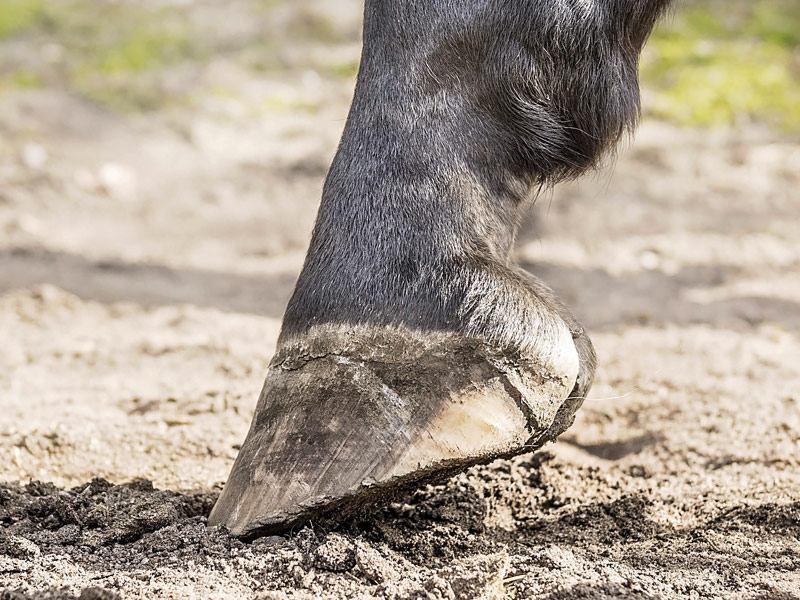Through most of human history, people believed the horse’s hoof was nothing more than a solid block with little, if any, feeling in it. In medieval times, for example, horses were brought into captivity, placed in small areas and forced to stand around in their own urine and feces. Within weeks of this domestic confinement, the integrity of the hoof began to break down and disintegrate, often leading to lameness.
The band-aid solution was to nail a piece of steel on the hoof to prevent it from falling apart. People subsequently came to believe that horses could not function or perform without the protection of these metal shoes, which also became fashionable and a sign of wealth.
This practice was challenged over 200 years ago by Dr. Bracy Clark of the Royal Academy of Veterinarians in London, England. But up to around ten years ago, the practice of nailing metal to the bottom of a horse’s hooves has persisted.
Today, we have exceptional diagnostic equipment that supports the scientific research proving horses should not have steel nailed to their hooves. Most horse people would now agree that the hoof is a highly vascular construction, and pumps blood very much like the heart does.
The Restricted Hoof
When a blacksmith nails a metal shoe to the bottom of a hoof, the foot is lifted up and in a contracted state while the shoe is being attached. When the now restricted hoof is placed back down and returned to its load-bearing state, it can no longer flex open and fill with blood. Because blood flow into it is diminished, the necessary diffusion of nutrient-rich blood and oxygen can’t enter and gain access to the microscopic nerves and blood vessels in the hoof. The hoof soon becomes numb or anaesthetized with reduced sensation, falsely leading us to believe that the unsound horse is now sound. Since the horse no longer has optimal feeling in the hoof, he now loads it without truly knowing what’s under it, all the while inflicting damage on it.
Negative Effects of Diminishing Hoof Mechanics
Dr. Robert Bowker’s research on hoof mechanics further demonstrates the detrimental effects on locking the foot down and not allowing it to function properly. Correct mechanics are only achieved when the horse lands heel first. Think of blood perfusion into the hoof as being like a garden soaker hose, which emits a fine spray along its length, nourishing the tissues and nerves as it goes. When we inhibit the correct action and mechanics of a hoof, the blood shoots into the foot and right back out without reaching the micro-vessels. This lack of blood flow results in nerve damage and the horse loses feeling in the foot.
The natural perfusion of blood into the hoof also plays a large role in shock absorption. As the hoof loads and fills fully with blood, it dissipates the energy and shock of the landing. As it lifts off the ground, the blood leaves the hoof and circulates back up the legs and through the body and heart. Without this blood cushion, the shock is absorbed by the ligaments, tendons and joints. We don’t really know the overall effects this lack of circulation has on the rest of the horse’s body, such as his kidney, liver, heart, etc. In humans, hypoxia occurs when one or more regions of the body are cut off from blood flow and deprived of oxygen, leading to gangrene or necrosis of the affected limb; generalized hypoxia mostly affects the brain, heart, pulmonary vessels and liver. Could that same generalized hypoxia be occurring in horses with diminished hoof mechanics?
The Importance of Proper Blood Flow in the Foot
When I first began studying the negative effects of shutting down hoof mechanism, I witnessed something I will never forget. I was trimming at a client’s farm on a cold winter day. Out in the paddock was a horse that was shod on all four feet. He was noticeably very uncomfortable and distressed as he shifted from foot to foot, continuously lying down and getting up (it was not colic). The thing that stuck in my mind to this day was how the horse’s hair was frosted with ice from the hooves all the way up to the middle of his belly. My heart sank with despair as I watched, unable to help this poor horse who was obviously in pain.
The horse’s hooves have shunts in them that open and close on demand to regulate the foot’s temperature. When we interfere with the hoof’s mechanism, we prevent those shunts from working correctly and the horse can no longer regulate his overall temperature.
In conclusion, whenever we impair hoof mechanism and reduce blood flow into the foot, 80% of its shock absorption is lost, placing stress on the ligaments, joints, heart, lungs and other organs. This loss of shock absorption increases impact on the front legs, and those forces acting on the hoof and body, and is one of the direct contributors to EIPH (Exercise-Induced Pulmonary Hemorrhage) in racehorses.
In order for the horse to function and perform at his optimal and healthiest level, the mechanics of his hooves need to be operating fully and correctly.
REFERENCES: Jaime Jackson, Dr. Hiltrud Strasser, Dr. Robert Bowker, Dr. Robert Schroter, Dr. J. Rooney








